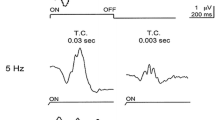Summary
Purpose: Analysis of a consecutive series of patients suffering from hereditary macular dystrophies.
Patients and methods: Between 1991 and 1997, 136 patients underwent clinical and electrophysiologic examinations (Ganzfeld ERG, EOG or multifocal ERG).
Results: The time of first examination was similar to the onset of clinical signs in most patients. In half of the patients onset was not before 40 years of age. In younger patients, Stargardt disease, X-linked retinoschisis and Best disease were the most frequent disorders. In patients aged 40 year and older, pattern dystrophies and central areolar choroidal dystrophy were more frequent. In 41 cases (30.2 %) a specific diagnosis could not be made. Color vision and multifocal ERG were abnormal in all patients examined. Ganzfeld ERG was important for the diagnosis of X-linked retinoschisis, as was the EOG for Best disease.
Conclusions: Hereditary macular dystrophies are a heterogeneous group of disorders. In several cases a definite diagnosis could not be made. Pattern dystrophies are the most frequent hereditary macular dystrophies in patients older than 40 years of age.
Zusammenfassung
Fragestellung: Analyse einer konsekutiven Serie von Patienten mit hereditären Makuladystrophien.
Patienten und Methoden: Von 1991 bis 1997 wurden 136 Patienten klinisch und elektrophysiologisch (Ganzfeld-ERG,EOG und/oder multifokales ERG) untersucht.
Ergebnisse: Der Zeitpunkt der Erstuntersuchung war bei den meisten Patienten weitgehend identisch mit dem Beschwerdebeginn. Bei der Hälfte der Patienten traten erste Symptome ab dem 40. Lebensjahr auf. Bei jüngeren Patienten waren M. Stargardt, x-chromosomale Retinoschisis und M. Best die häufigsten Diagnosen, bei Patienten ab 40 Jahren überwogen die Musterdystrophien und die areoläre Aderhautdystrophie. In 41 Fällen (30,2 %) war eine eindeutige Zuordnung zu einer spezifischen Makuladystrophie nicht möglich. Farbensehen und multifokales ERG waren bei allen damit untersuchten Patienten pathologisch. Das Ganzfeld-ERG war bei der x-chromosomalen Retinoschisis, das EOG beim M. Best differentialdiagnostisch entscheidend.
Schlußfolgerungen: Hereditäre Makuladystrophien sind eine heterogene Gruppe von Erkrankungen. Eine eindeutige Differentialdiagnose ist nicht selten unmöglich. Musterdystrophien sind die häufigste hereditäre Makuladystrophie ab dem 40. Lebensjahr.
Similar content being viewed by others
Author information
Authors and Affiliations
Rights and permissions
About this article
Cite this article
Kellner, U., Jandeck, C., Kraus, H. et al. Hereditary macular dystrophies. Ophthalmologe 95, 597–601 (1998). https://doi.org/10.1007/s003470050321
Published:
Issue Date:
DOI: https://doi.org/10.1007/s003470050321




